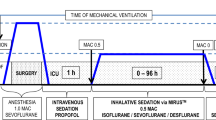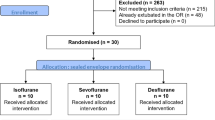Abstract
Objective
A recent clinical trial compared a minimum alveolar concentration (MAC)-based protocol to an electroencephalography (EEG)-based protocol for the prevention of intraoperative awareness. One limitation of this study design is that MAC-based protocols are not sensitive to the use of intravenous agents, while EEG-based protocols are. Our objective was to develop a MAC alert that incorporates intravenous agents.
Methods
We developed an electronic algorithm and alerting system that calculates a total age-adjusted MAC value based on inhalational agents, but also incorporates intravenous agents. We retrospectively applied the algorithm to adult general anesthesia cases over a 1 year period to assess the frequency of alert triggers, using thresholds of <0.8, <0.7, <0.6, <0.5 and <0.4 age-adjusted MAC. We also electronically analyzed 12 cases of intraoperative awareness that occurred over a 4-year period for the frequency of alert triggers using the same thresholds. Finally, we calculated positive and negative likelihood ratios based on these analyses.
Results
Over a 1-year period we identified 15,091 cases without self-reported awareness that were valid for analysis. At all age-adjusted MAC thresholds, the incidence of triggered alerts was higher in the awareness cases. The threshold of<0.8 age-adjusted MAC was associated with the highest negative likelihood ratio; the<0.5 age-adjusted MAC was associated with the highest positive likelihood ratio.
Conclusions
Our novel electronic alerting system incorporates both age-adjusted MAC and intravenous anesthesia, and triggers with a higher frequency in cases of awareness. These data suggest the potential for our system to alert clinicians to insufficient anesthesia.
Similar content being viewed by others
References
Mashour GA. Monitoring consciousness: EEG-based measures of anesthetic depth. Semin Anesth Perioper Med Pain. 2006;25:205–10.
Myles PS, Leslie K, McNeil J, et al. Bispectral index monitoring to prevent awareness during anaesthesia: the B-Aware randomised controlled trial. Lancet. 2004;363:1757–63.
Avidan MS, Zhang L, Burnside BA, et al. Anesthesia awareness and the bispectral index. N Engl J Med. 2008;358:1097–108.
Smith C, McEwan AI, Jhaveri R, et al. The interaction of fentanyl on the Cp50 of propofol for loss of consciousness and skin incision. Anesthesiology. 1994;81:820–8.
Aantaa R, Jaakola ML, Kallio A, et al. Reduction of the minimum alveolar concentration of isoflurane by dexmedetomidine. Anesthesiology. 1997;86:1055–60.
Nickalls RWD, Mapleson WW. Age-related iso-MAC charts for isoflurane, sevoflurane and desflurane in man. Br J Anaesth. 2003;91:170–4.
Eger EI. Age, minimum alveolar anesthetic concentration, and minimum alveolar anesthetic concentration-awake. Anesth Analg. 2001;93:947–53.
Mashour GA, Wang LYJ, Turner CR, et al. A retrospective study of intraoperative awareness with methodological implications. Anesth Analg. 2009;108:521–6.
O’Reilly M, Talsma A, VanRiper S, et al. An anesthesia information system designed to provide physician-specific feedback improves timely administration of prophylactic antibiotics. Anesth Analg. 2006;103:908–12.
Kheterpal S, Gupta R, Blum JM, et al. Electronic reminders improve procedure documentation compliance and professional fee reimbursement. Anesth Analg. 2007;104:592–7.
Takita A, Masui K, Kazama T. On-line monitoring of end-tidal propofol concentration in anesthetized patients. Anesthesiology. 2007;106:659–64.
Umesh G, Jasvindere K, Shetty N. Low minimum alveolar concentration alarm: a standard for prevention of awareness during general anaesthesia maintained by inhalational anaesthetics. J Clin Monit Comput. 2009;23(3):185–6.
Acknowledgments
This work was supported, in part, by a grant from the Foundation for Anesthesia Education and Research (GAM, Principal Investigator).
Author information
Authors and Affiliations
Corresponding author
Additional information
Mashour GA, Esaki RK, Vandervest JC, Shanks A, Kheterpal S. A novel electronic algorithm for detecting potentially insufficient anesthesia: implications for the prevention of intraoperative awareness.
Rights and permissions
About this article
Cite this article
Mashour, G.A., Esaki, R.K., Vandervest, J.C. et al. A novel electronic algorithm for detecting potentially insufficient anesthesia: implications for the prevention of intraoperative awareness. J Clin Monit Comput 23, 273–277 (2009). https://doi.org/10.1007/s10877-009-9193-9
Received:
Accepted:
Published:
Issue Date:
DOI: https://doi.org/10.1007/s10877-009-9193-9




